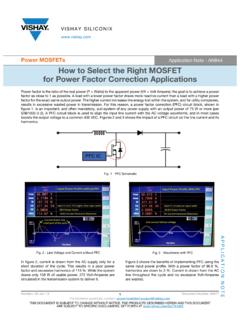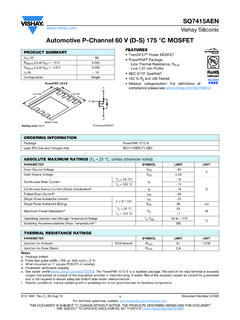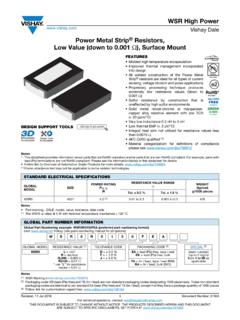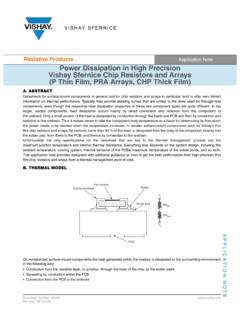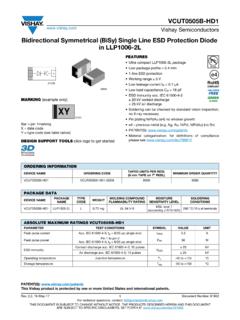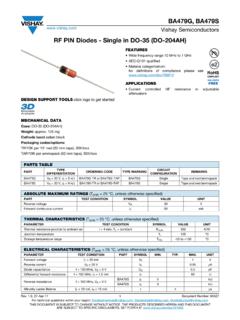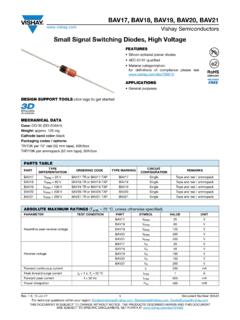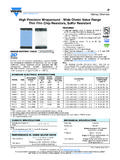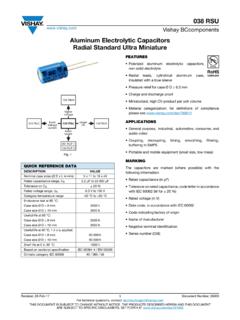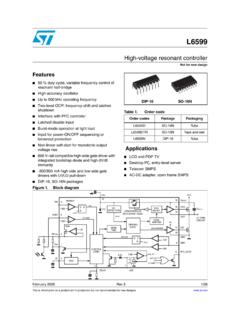Transcription of MOSFETs Zero-Voltage Switching Full-Bridge Converter ...
1 VISHAY SILICONIXMOSFETsSystem Application Note AN847 Zero-Voltage Switching Full-Bridge Converter : Operation, FOM, and Guidelines for MOSFET SelectionAPPLICATION NOTE Revision: 15-Dec-141 Document Number: 90936 For technical questions, contact: DOCUMENT IS SUBJECT TO CHANGE WITHOUT NOTICE. THE PRODUCTS DESCRIBED HEREIN AND THIS DOCUMENTARE SUBJECT TO SPECIFIC DISCLAIMERS, SET FORTH AT Philip Zuk and Sanjay HavanurThere are two categories of Switching topologies used in power conversion design, referred to as hard and soft Switching topologies. The main difference between hard and soft Switching is that in hard Switching during turn ON, a voltage equal to at least the supply voltage is impressed upon the MOSFET and the current tends to flow from drain to source, resulting in high turn ON losses. In soft Switching , the current at turn ON is oriented from source to drain, which discharges the MOSFET s output capacitance (Coss) before turning the device on, thereby eliminating turn ON losses.
2 Initially, the parasitic MOSFET body diode conducts and when the MOSFET is activated the current commutates to the channel. Figures 1a and 1b show the difference between a hard-switched waveform with turn ON and turn OFF crossover losses versus turn OFF losses for Zero-Voltage Switching (ZVS). One characteristics of soft Switching is that the gate voltage will begin to rise only after drain-source voltage comes down very close to zero. As operating frequencies continue to climb, more designs are being converted into soft Switching modes to save the Switching losses. Fig. 1a - Standard Hard-Switched WaveformsFig. 1b - ZVS WaveformsVDSIDTurn ONhard switchedoverlap lossesTurn OFFhard switchedoverlap lossesVDSIDTurn OFFhard switchedzero overlap lossesTurn ONsoft switchedoverlap lossesZero- voltage Switching Full-Bridge Converter : Operation, FOM, and Guidelines for MOSFET SelectionAPPLICATION NOTES ystem Application Note Siliconix Revision: 15-Dec-142 Document Number: 90936 For technical questions, contact: DOCUMENT IS SUBJECT TO CHANGE WITHOUT NOTICE.
3 THE PRODUCTS DESCRIBED HEREIN AND THIS DOCUMENTARE SUBJECT TO SPECIFIC DISCLAIMERS, SET FORTH AT are several topologies used in the soft Switching category. On the primary side the most common configurations are active reset, LLC, and ZVS full bridge (ZVSFB), and SSR on the secondary side. This design guide will focus specifically on the ZVSFB arrangement shown in Figure 2, which is typically found in telecom bricks and AC/DC power supplies. The ZVS topology is often referred to as a phase-shifted full bridge , meaning a full bridge that invokes phase shifting between the two arms in order to achieve ZVS. The phase-shifted Full-Bridge Converter clamps and recycles the energy stored in the power transformer s leakage inductance to softly turn ON each of the four power MOSFETs . This improves efficiency, reduces Switching -related EMI, and eliminates the need for primary-side 2 - Typical ZVSFB CircuitWHY Zero-Voltage SWITCHINGWhen a MOSFET turns on, there are losses due to voltage and current overlap (Figure 3) and the discharge of stored energy in its Coss capacitor.
4 In ZVS the Coss is tricked into discharging its energy prior to turning on the MOSFET. Usually the MOSFET s body diode goes into conduction in the process. It should be noted that ZVS operation eliminates only turn ON losses; Switching losses during turn OFF, both due to overlap and Coss charging, will still be incurred. Fig. 3 - Turn ON Switching LossesVGSCossVDSIDSTurn ON Switching loss in a MOSFETZero- voltage Switching Full-Bridge Converter : Operation, FOM, and Guidelines for MOSFET SelectionAPPLICATION NOTES ystem Application Note Siliconix Revision: 15-Dec-143 Document Number: 90936 For technical questions, contact: DOCUMENT IS SUBJECT TO CHANGE WITHOUT NOTICE. THE PRODUCTS DESCRIBED HEREIN AND THIS DOCUMENTARE SUBJECT TO SPECIFIC DISCLAIMERS, SET FORTH AT OPERATION OF ZVS PHASE-SHIFTED full BRIDGEF igures 4a to 4f show the typical operation of a standard phase-shifted ZVSFB. Starting at the upper left with the basic bridge circuit and following the arrows we have the following: Figure 4b: MOSFETs Q1 / Q2 are turned on and Q3 / Q4 are off.
5 Primary current (blue) flows, delivering power to the secondary through transformer T1. Figure 4b: Q2 turns off, primary current flows through output capacitance Coss of Q3 and discharges it. Load current now flows through the output rectifiers and there is no power transfer from primary to secondary. Figure 4d: Once the Coss of Q3 is discharged, the magnetizing current continues to flow through the body diode of Q3, which is now turned on with zero voltage across it. The magnetizing current now flows through the channel and not the body diode. The duration of this interval may be varied by the controller to maintain output regulation. Figure 4e: Q1 is turned off and the magnetizing current finds its path through Q4, discharging its Coss. Once Cossis fully discharged the magnetizing current forward biases its body diode. Figure 4f: Q4 can now be turned on with ZVS.
6 power transfer to the secondary is resumed. At the end of this interval Q3 is turned off and the sequence is repeated. IMPORTANCE OF MOSFET BODY DIODE IN ZVS CIRCUITSA lthough the MOSFET body diodes conduct during every transition, it is evident that they are not subject to hard commutation. The diode current is commutated softly by the channel of the parent MOSFET. However, this does not mean that reverse recovery of the diode may be ignored in ZVS applications. In the interval of Figure 4f, the body diode of Q3 needs to regain its ability to block high voltage before Q3 is turned off. If the Q3 body diode does not recover or start blocking the rail or main voltage , the bridge may be subject to what is commonly known as shoot through, resulting in high currents through Q2 and the body diode of Q3. Q2 / Q3 may not fail immediately, but over time they will continue to dissipate heat which leads to failure.
7 Failures may also happen unexpectedly during line and load problems associated with body diode recovery increase exponentially with the voltage rating of the device. For example, the Qrr of a 100 V MOSFET used in 48 V telecom systems is in the range of tens of nC, whereas for standard 600 V superjunction devices it will be several C. Most low- voltage MOSFETs can be used in ZVS mode up to several hundred kHz. However, fast body diode (FBD) versions of high- voltage power MOSFETs are recommended in ZVS topologies. Typically, the FBD MOSFETs are designed to have a 5 x to 10 x reduction in the reverse recovery charge Qrr for their body diodes. Looking at the Qrr of the SiHG47N60E-GE3 (standard MOSFET) versus the SiHG47N60EF-GE3 (FBD MOSFET), one would see a Qrr of 11 C versus C, respectively, which also results in a 4 x reduction in trr.
8 The lower Qrr results in a faster recovery time during soft commutation. The ability of the MOSFET s body diode to block high voltage , which is crucial to the safe operation of any ZVS topology, is greatly enhanced in the FBD MOSFETs . Zero-Voltage Switching Full-Bridge Converter : Operation, FOM, and Guidelines for MOSFET SelectionAPPLICATION NOTES ystem Application Note Siliconix Revision: 15-Dec-144 Document Number: 90936 For technical questions, contact: DOCUMENT IS SUBJECT TO CHANGE WITHOUT NOTICE. THE PRODUCTS DESCRIBED HEREIN AND THIS DOCUMENTARE SUBJECT TO SPECIFIC DISCLAIMERS, SET FORTH AT 4 - Operating Sequence of a ZVS Phase-Shifted full BridgeLOSS ANALYSIS FOR MOSFETs IN A ZVS full BRIDGEV ishay strongly recommends that MOSFET selection for any topology should be made based on application-specific power losses, rather than generic figures like RDS(on) x Qgproduct. Towards that end, several design and MOSFET selection guides have been published covering different topologies.
9 The power loss for a phase-shift ZVSFB is shown below. You can see that the equation takes into account conduction, Switching , output, gate drive and body diode losses. The following represent the definition of each variable used in the power loss equation below: PIN - input power to the power supplyTCR - temperature coefficient of resistance (typically Figure 4 within Vishay s HVM datasheets)RDS - typical on-resistance value of the device Qsw - Switching change, being a combination / ratio of Qgsand QgdIgoff - MOSFET gate drive turn OFF currentfsw - Switching frequency of the phase-shifted ZVSFBQoss - output chargeVDR - output voltage of the gate driver that drives the MOSFETQg - gate chargeVfwd - forward voltage drop of the MOSFET body diodetdead - dead time for the MOSFET body diode to recover before turning the MOSFET on+LlkT1Q4Q1 CINLX1 IPRIQ2Q3LX2+ +LlkT1Q4Q1 CINLX1 IPRIQ2Q3LX2+ +LlkT1Q4Q1 CINLX1 IPRIQ2Q3LX2+ +LlkT1Q4Q1 CINLX1 IPRIQ2Q3LX2+ No power is being deliveredto load during transition +LlkT1Q4Q1 CINLX1 IMAGQ2Q3LX2+ +LlkT1Q4Q1 CINLX1 IPRIQ2Q3LX2+ ZVS turnON for Q4 ++Typical ZVS bridge Q1 and Q2 delivered to loadQ2 turned OFF.
10 Current moves to Q3 body diodeQ3 Coss is discharged. Preparing for ZVS turn ON ..Q3 turned ON with ZVS. Current moves to Q3 channelQ1 turned OFF. Current moves to Q4 body diodeQ4 Coss is discharged. Preparing for ZVS turn on .. power delivered to loadin the second half cycle Q4 turned ON with ZVS. Current moves to Q4 channelFigure 4aFigure 4bFigure 4cFigure 4dFigure 4eFigure 4fZero- voltage Switching Full-Bridge Converter : Operation, FOM, and Guidelines for MOSFET SelectionAPPLICATION NOTES ystem Application Note Siliconix Revision: 15-Dec-145 Document Number: 90936 For technical questions, contact: DOCUMENT IS SUBJECT TO CHANGE WITHOUT NOTICE. THE PRODUCTS DESCRIBED HEREIN AND THIS DOCUMENTARE SUBJECT TO SPECIFIC DISCLAIMERS, SET FORTH AT ZVS, the conduction losses dominate, followed by the Coss-related losses. As a result, the application-specific figure of merit (FOM) gets biased towards RDS(on) and Qrr / Qoss (Coss losses in a MOSFET come from a combination of Qrr / Qoss).
